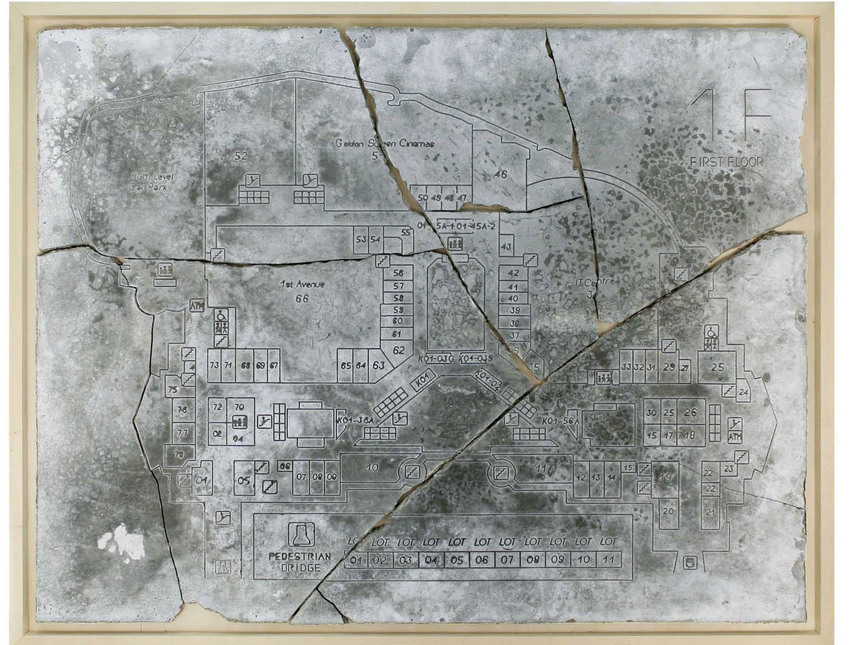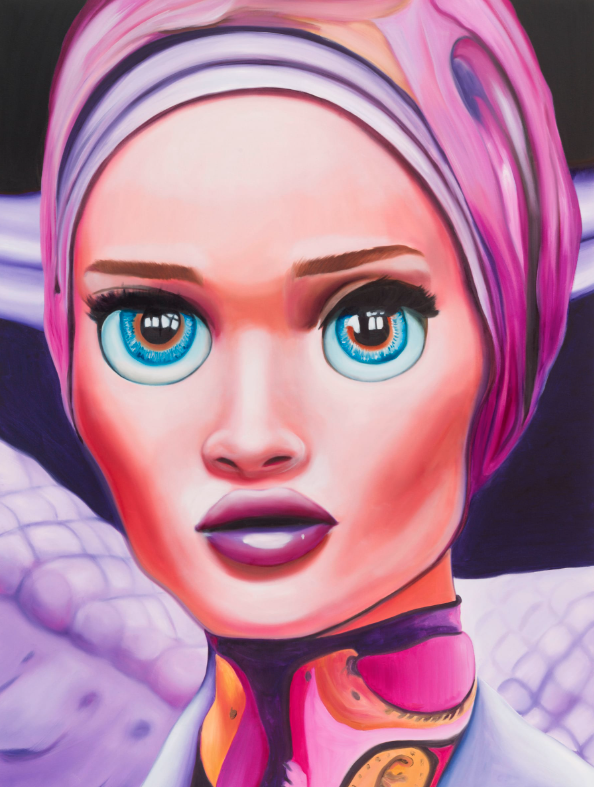 Andrea Francolino, Berjaya Times Square, 2013, concrete and wood, 116.5 x 149 cm
Andrea Francolino, Berjaya Times Square, 2013, concrete and wood, 116.5 x 149 cm
31st of July – 7th of September 2014 www.kristinhjellegjerde.com
“Nothing beside remains. Round the decay of that colossal wreck, boundless and bare. The lone and level sands stretch far away.” Percy Bysshe Shelley
Imagine a time when all that we know is gone. Towering skyscrapers and concrete giants, all that epitomises humankind’s modern achievement, are powerless in the face of time. Gleaming walls of glass and marble are reduced to dust and rubble. Imagine, now, what would remain among the rusted, twisted steel and desiccated piles of stone – a tendril of something green, vibrant and alive. New leaves sprout from a mountain of concrete, rising delicately towards the sun. It is nature, creeping back, coming to reclaim this wasteland, for even in the bleakest place there is always life. In Andrea Francolino’s solo exhibition, A-Biotic (31 July – 7 September), the artist does not predict a post-Apocalyptic world, but rather, explores our contemporaneity and what it means to be human within a consumerist society. “Consumerism, consumerist behaviour, hedonism, waste, technocracy, uniformity, climate change and hunger are all part of our era,” he says. “I need to a find a way to think and communicate the meaning of life in all of this, and what it means for us to be human at this time.”
Francolino’s practice has long examined these issues; the artist works, most notably, with products and packaging. In A-Biotic, he takes on the mother of all packaging and perhaps one of the most iconic symbols of our time – the megamall, which packages not just objects for us, but the dream of a better lifestyle. “These locations gather millions of people whose goal is to find wellbeing through materialistic fulfillment,” he says. “Malls have become places of pilgrimage, destinations to visit, where objects are gazed upon and longed for, to extent that they must be possessed.” The result is The Concrete Mall series, a set of large-scale works depicting the floor plans of various shopping metropolises around the world.
Minnesota’s famous Mall of America, Dubai Mall and even the SM Mall of Asia in the Philippines are all rendered in crisp lines and fine detail on smooth slabs of concrete encased in wooden frames. They could be blueprints for futuristic spaceships, a series of unfamiliar yet familiar lines and arcs, thoroughfares, galleries and architectural details. The twist comes two-fold: first, once each floor plan is complete, Francolino takes the perfect slab and breaks it – smashes it into a myriad of pieces which he then reconstructs like a flawed, frayed puzzle. “The bigger and more ambitious the structure I break, the more helpful it is in showing symbolically the dimensions of human vulnerability,” he says. It is this act of building and breaking that is the key to understanding Francolino’s practice. “Concrete is perceived as a strong material and huge structures seem eternal and indestructible. However, compared to eternity, nothing that man builds is so. It is not a criticism, but rather, an awareness of our own fragility and intransience.” For the artist, the act of building and breaking are one and the same, a conscious archaeological process that reminds us that all that we see could one day be the past – a series of ruins examined by future generations of a time long gone by, like our present excavations of the Parthenon or the Colosseum. “We need to protect, shelter and renew what we use, not merely consume,” says Francolino. “Otherwise our own behaviour may just accelerate our disappearance.” The second kicker, then, comes in the use of a wooden frame for each reassembled mall. Encasing the manmade with its natural counterpart, they take on the appearance of altarpieces – a strange fusion of the man-made and the natural, with the latter in the win.
More dramatic still is A-Biotic, the work from which the exhibition derives its name. The floor plan of a mall is once again recreated, but this time, directly into the gallery wall through a series of 800 holes into which steel rods are inserted. The effect is that of an almost aerial view, looking down upon towers sprouting out in the shape of a mall. Then, nestled in its centre, balancing on the steel rods, is a simple potted plant. The title itself is an amalgamation of the words ‘abiotic’ and ‘biotic’, terms used in the study of ecosystems. While the former refers to non-living and physical components that effect ecosystems, the latter relates to all vegetal and animal components. “‘A’ and ‘biotic’ represent the dualism between what is alive and what is not, and draws the distinction between the meaning of life and the meaning of human materialism,” explains Francolino. “Within A-Biotic, all plants are represented by this one plant, the biotic, which has, against all odds, grown up surrounded by a jungle of reinforced bars – the abiotic.”
Organic matter also makes an appearance in the poignant Performance of a Plant. “To make the concrete mall plans requires extreme precision,” explains Francolino. “The cement might not dry because of humidity, or it cracks, or I break it into so many small pieces I am actually unable to reconstruct it.” These pieces get thrown out into a junkyard outside the artist’s studio, where he witnessed something miraculous. “As so often happens, a plant grew out of the cement remains, which I had hoped would happen. That rubbish recovered its meaning, thanks to a plant.” Within the gallery, Francolino will recreate this phenomenon by gathering concrete detritus into a pile as a semi-performance piece. A plant will be gently placed within the pile’s apex, a sign of renewed life even where it seems that it would be most impossible.
The pièce de résistance, however, is Et Onne Tempo, winner of the prestigious 2014 San Fedele Prize. Here, the concrete slab is replaced with concrete dust, into which a mall floor plan has been stencilled, rather like lines in the sand. Inspired by Saint Francis of Assisi’s Cantico Dei Cantici, the work’s tremulous existence is completely reliant on the environment around it – a gust of wind or a drop of water will utterly destroy it. All that we are, Francolino seems to be saying, is transient. Yet, within the great cycle of life, even the most immovable can be moved, and where it is pushed away and trampled, nature will always come back to reclaim its right.
“Basing our entire lives simply on consuming and possessing – this is what makes us so transient. Man builds ever more powerful weapons and bigger buildings and we consume the earth,” says Francolino. “We think what we create will last forever, but nothing is as mysterious and enduring as nature and creation. Even art and music are the result of elements and ingredients given to us by nature.” By breaking down these contemporary symbols, these mega malls, we can find new meaning in their reconstructed forms – from within the cracks and crevices left behind, new life will always emerge. “I use these cracks to find the meaning of life,” says Francolino. “Life goes ever onwards towards two simple directions, the beginning and the end and the endless cycle between the two.”
With thanks to Emanuela Catena and Giacomo D’Eredità for their translation.
About The Artist
Born in Bari, Italy (1979), Andrea Francolino attended the Art School of Matera, before studying at the Accademia delle Belle Arti, from where he graduated in 2004 with a Degree in Sculpture. Working in painting, photography, sculpture and digital art, Francolino seeks to use a combination of strong messages and concepts (at times unwelcome) in order to communicate his thoughts on a consumerist and ad-consumed society. In his latest work, he uses concrete as the main material, recounting therein the vulnerability of man and perfection of nature. Selected solo exhibitions include Journey Into Reality, Spazio Testoni, Bologna (2013) and Made in Kyoto, 999Contemporary Gallery, Rome (2012). Group exhibitions include The Masks We Wear, Kristin Hjellegjerde (ARTECO), London, UK (2013); Milan Jam, Collyer Bristow Gallery, London, UK (2012) and exhibitions throughout Italy. Francolino currently lives and works in Milan. For more information, visit www.andreafrancolino.com.








